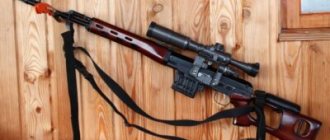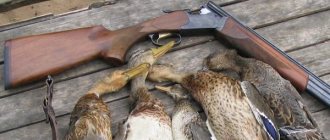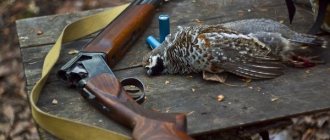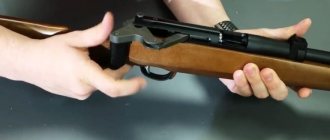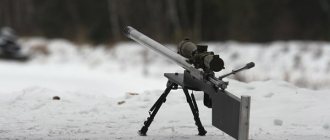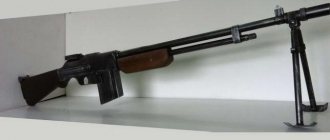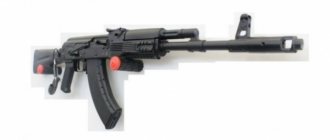Bear hunting has always been considered the pinnacle of the hunting craft. A trophy at the end of this hunt is a source of pride for any hunter, a test of courage, endurance and skill. In order to approach the issue of choosing a weapon, it is necessary to understand the basic subtleties of bear hunting. The bear is a very smart and fast animal, resistant to wounds and hardy. The main task of a bear hunt is to stop the animal with one shot. The hunter may not get a chance to fire a series of shots.
Description of the carbine
“Bear” is a whole family of self-loading rifled carbines designed for commercial hunting and shooting large animals. Such rifles use 7.62x51 mm cartridges for firing, and even a Mosin rifle would envy their destructive power. In addition, the Bear carbine has a number of design features, which is why many hunters prefer it:
- the presence of a rubber shock absorber on the back of the butt - designed to soften the recoil effect;
- automatic safety, the effect of which extends to the sear - reduces the likelihood of an accidental shot to almost zero;
Carbine "Bear" with optical sight
- the trigger system is located in a special box, and not in the stock, which greatly simplifies the procedure for disassembling and cleaning the weapon;
- the rear sight has several divisions - facilitates the process of zeroing a weapon at distances from 100 to 300 meters, even without optics;
- the presence of an 11-mm dovetail bracket - allows you to install an optical or collimator sight on the weapon;
- the butt and receiver are made of high-quality wood - increases the life of the gun and improves its appearance.
Generally speaking, this whole mass of features makes the Bear a convenient and reliable carbine that is completely safe to use. The model also has good technical characteristics.
Basic aspects of bear hunting
The stopping effect of a shot depends on many factors, some of which depend on the skill and experience of the hunter, some on the weapon and its characteristics. Let's take a quick look at these factors:
- The shot must be made "on the spot." In order to immobilize an animal, you need to know the slaughter area and accurately hit it. Hunting stories contain stories about a well-aimed and correct shot even from a small caliber, but only experienced hunters can do this. The killing areas of a bear are the heart, spine, area of the front shoulder blades and, in some cases, the brain. Legends about the extreme strength of a bear’s skull have no basis; the skull is equally strong in any animal. It's all about the thick fur, which visually increases the area of the head and the slope of the bear's forehead.
- A bullet hit on an animal should have a high shocking effect. If the bullet misses, it won't stop the bear. This effect can be achieved with special ammunition, expansive bullets, and special types of weapons. Even if a heavy hollow point bullet does not hit the spot, but has great energy, the animal will be shocked for some time by the impact.
- In order to be able to fire the correct shot and be able to shoot again, high demands are placed on weapons for such a hunt. In this case, there are no trifles, and the slightest failure can cause an unsuccessful hunt and is often fraught with danger for the hunter.
These three factors are closely interrelated. Hunting cartridges and weapon choice can to some extent compensate for the lack of experience. And knowledge of the anatomy of the animal, its habits and personal composure increases the chances of success many times over. And yet, the choice of weapon is the main objective factor for a successful hunt, and the issue of ammunition is also connected with it.
Specifications
In terms of its technical parameters, the Bear is often compared to the Mosin rifle. It is the high destructive power and good accuracy even at long distances that make the carbine so popular. In the weapons passport, the performance characteristics are presented in the form of a small table:
| Characteristic: | Parameter: |
| Barrel type | threaded |
| Number of rifling | 4 |
| Ammunition used | 7,62×51 |
| Carabiner length | 1110 mm |
| Barrel length | 550 mm |
| Store capacity | 3 + 1 |
| Weapon weight | 3.3 kg |
Despite the relatively small dimensions and rather short barrel, the dispersion indicator is no more than 3 centimeters when shooting at a distance of 50 meters. The standard sighting device uses a classic rear sight and a front sight of an open or closed type (depending on the modification). To install optics or a collimator, a dovetail sighting bar (11 millimeters) was provided.
Other types of hunting
In addition to den hunting, there are many more types of fascinating and exciting game prey:
- on oats;
- from the approach;
- with dogs;
- on bait;
- with a knife.
Used at different times of the year, all these types are in no way inferior in excitement and adrenaline rush to hunting in dens, because here waiting for the appearance and hiding of a bear also requires fortitude and enormous endurance.
On oats
This type of bear hunting is suitable for non-professionals. Knowing the bear's predilection for ripened oats, they ambush him. However, the slightest noise can scare away the predator, and it leaves, snorting and chattering its teeth. It is better to select areas for hunting where the forest is close to the plantings.
The storage shed should be prepared on the leeward side, and traces of construction should be removed well. A hut will not be such an effective shelter, since the animal can smell it, and it is not very convenient to see the area from behind the branches.
The bear will come to feast on oats at dusk, so it is better to occupy a place in an ambush or storehouse in the evening. If you are hunting oats from the approach, you should go around the field in the early morning: the bear in the morning is not as vigilant as in the evening, so you will be able to sneak up on it at a fairly close distance.
Hunting from the approach
This is a risky type of bear hunting, and therefore it is advisable to carefully prepare for it.
Wear clothes made from natural fabrics, as they will create less noise when coming into contact with ears of oats. A hat with a protective pattern is put on the head, and sneakers or soft sneakers are put on the feet. When the animal begins to rise above the field, you should press yourself to the ground.
If you spot a bear grazing in a field using binoculars, move only from the leeward side. Walk while the animal is feeding, avoiding making noise when it is listening.
It is safer to hunt in the morning than in the evening, since shots in the light are more accurate, and the wounded animal is easier to see from a distance.
Hunting with dogs
Bear hunting in the fall is carried out with the participation of experienced dogs - bear hunters, who can easily find a hidden animal, especially if the snow is not too deep. Bear hunting with dogs begins when the bear has already gained fat and shed. During this period he has a rich, long coat.
Usually, sensing dogs, a bear tries to find support in the form of a tree or stone, sit with its back to it and fight off the dogs’ attack. The dogs are able to hold the bear until the owner arrives, who stops the fight between the animals with a point-blank shot.
If the wounded animal does leave, dogs should not be allowed to track it in the evening: finding a wounded animal in the morning is safer for dogs and will not be difficult.
Hunting on bait
This kind of bear hunting is one of the most effective and common ways to hunt the animal in the spring. Having lost weight over the winter and being hungry after a long hibernation, the bear rushes for any food, including carrion. For bait, you usually take a barrel with stones, between which there is bait in the form of meat and fish. The barrel itself is firmly secured among cobblestones and snags so that the bear does not drag away the bait.
Another way to organize a bait: place a dead carcass with its head facing north or east in a log house made of birch logs. The bear will smell the carrion and will try to get close to it, and against the background of white trunks it is easy to notice. You can lure a predator by placing pieces of meat and fish along the path leading to the bait site.
The ambush is made higher than the bait itself, so that it is more convenient to view the surroundings. It is necessary to shoot just below the slaughter point, since optical illusion can be misleading, and the bear itself may appear taller than it actually is.
Modifications
Over the several decades of its existence, the Bear carbine has received several official modifications, each of which has its own key features. It is important to note that the later the upgrade was released, the larger the circulation it had. So weapons from the Soviet Union can now only be purchased secondhand from current owners. But modern modifications are sold in gun stores to any hunter with 5 years of experience. The following is a brief overview of only the most interesting existing versions of “The Bear”.
SOK-9 "Bear"
A 9mm version of a hunting carbine, sharpened for shooting with 9x53mm cartridges. A soft-nosed bullet weighing 15 grams is used as a ballistic projectile. The length of the barrel remained unchanged, so the accuracy of the combat was not affected, but the penetrating ability decreased slightly. But the chamber, bolt, barrel channel, piston with frame and other metal elements received chrome plating, thanks to which the weapon no longer corroded. The release of this modification took place in 1965.
The automatic weapon reloading system has also undergone modernization. Now it is produced due to the action of powder gases, which enter a special chamber from the barrel, form pressure and force the piston to move, which opens the bolt frame and provokes compression of the spring. The ejection of the spent cartridge case is carried out under the action of an extractor. This system works almost flawlessly, giving the hunter the ability to use weapons even in extreme cold.
The Bear's trigger system also received some changes. Now it includes a special rotating trigger, as well as a combat spring. As soon as the hunter presses the “petal”, the trigger is activated, which hits the primer and ignites the powder mixture. Due to the heating process, the spring returns to its original place, which leads to automatic recharging. This system goes well with the removal of powder gases, since it works simultaneously with it.
"Bear-2"
The second version of the famous carbine, which largely repeats the characteristics of its ancestor. 9×53 mm bullets are also used here as a ballistic projectile, placed in a three-round magazine. The rifle is fundamentally different from the original version in that the cartridges are placed in a row rather than a checkerboard pattern - a more familiar option for most hunters. The carbine kit comes with three tanks in which you can place ammunition, as well as a four-fold optic designed for shooting from a distance of up to 150 meters. By the way, standard sights are also present.
"Bear-2" is much more tailored for hunting than "Bear-1", although the killing power of the first version is higher due to its larger caliber. Although it should be noted that in the Soviet Union only the most sophisticated hunters hunted large predators. Most amateurs preferred to hunt small and medium-sized fur-bearing animals or shoot young deer. For such purposes, “Bear-2” is almost ideal, since it uses ammunition for shooting that is more inexpensive and available in all gun stores. And despite the fact that the kit includes optics, this had almost no effect on the cost.
SOK-308 "Bear-3"
In the third version of the Bear carbine, the engineers decided to return to the roots, continuing to produce a rifle that fires 308 caliber cartridges. However, the model was released in small quantities due to the fact that it could not make the proper impression on hunters. "Bear-3" was practically no different from "Bear-1", except for the fact that the magazine was expanded to 4 rounds (in-line arrangement).
Rifle "Bear-3" 308 caliber
However, this modification was the first of the entire model range to be produced based on pre-orders from potential buyers. If desired, the hunter could choose a version with a replaceable choke or a six-fold optical sight included. The souvenir guns, which were distinguished by beautiful carvings and inserts of precious metals, deserve special mention.
"Bear-4"
The latest and most modern modification of the entire series, which made hunters talk about the legendary “Bear” again. Just like the carbine of the third version, this rifle uses 7.62x51 mm cartridges for firing. However, certain design features brought it to the forefront in comparison with the “four-chamber”:
- adjustment and polishing of the trigger mechanism - the combat has become sharper;
- the presence of a combined aiming bar - choice between 16 mm and 11 mm;
- staggered arrangement of cartridges - unusual, but more effective;
- extended equipment - includes spare parts kit and optics.
“Bear-4” also looks very modern. The wooden stock and stock were replaced with plastic analogues, characterized by a higher polymer content. The barrel received not only chrome plating, but also high-quality chemical blackening. A compensator appeared at the end of the barrel channel, and under it there was a bracket for attaching the body kit.
Ancient hunting with a spear
Bear hunting with a spear was common until the beginning of the 20th century. Rogatina is an ancient weapon that is still in demand when hunting clubfoot. From a primitive sharpened stake, the spear was transformed into an improved weapon against a huge beast. A triangular tip with sharply sharpened edges was attached to a powerful two-meter shaft.
To prevent the spear from getting stuck in the animal's body, a piece of horn (hence the name of the weapon) or a crossbar was tied to the shaft. Often, to prevent slipping, the pole was wrapped with leather straps, studded with nails, and horse hair or animal fur was hung so that the pole would not get dirty with blood. For lightness, the shaft was made hollow inside.
For the shaft, special trees with a straight trunk were chosen so as not to plan them additionally. Usually, young ash trees were grown for these purposes, since its wood is strong and will not break at the decisive moment of the fight. The trunk was wrapped with pieces of leather for even greater strength of the future object, as it was called in the old days. This technology for creating the shaft eliminated the slipping of hands along the bloody trunk.
Bear hunting in Siberia was carried out with a spear made a little differently. The Siberian spear was distinguished by its lightness and consisted of a knife mounted on a stick, tightly wrapped with boiled birch bark for strength.
In engravings of the 17th century you can see the amazingly beautiful design of the spear. Patterns and bumps appeared on the shaft thanks to a special technology. On the living trunk, the bark was cut in places and the desired pattern was cut out, then covered with bark again. And after a certain time, the grown trunk was cut down, dried, and the cuts, swollen in the shape of a pattern, looked like a skillful design.
A real spear was a double-edged blade (feather), called a “bear blade,” with a high rib and deep valleys along both blades for blood flow. The wider the feather, the more it injures the animal, damaging its bones and cervical vertebrae. A crossbar was installed at the base of the blade; it protected the hunter from the claws of a resisting bear.
Prince Shirinsky-Shikhmatov, a fan of bear hunting with a horn, who personally took more than a hundred clubfooted bears in this way, suggested using a feather with two spring-loaded knives. These knives opened already in the shaggy man’s body and left no chance to escape.
A rod, a knife, an ax and a sharp point for a long time remained reliable companions for the common man on a bear hunt. With a spear they hunted in the den and chased the animal with dogs. The burrow spear was more massive than the spear used in pursuit hunting. A centuries-old weapon, the spear served hunters well when paired with a sharp bear knife.
Disassembling weapons
All “Bears” have a similar design, so the procedure for disassembling them is the same in most cases. In order not to make a mistake anywhere, it is recommended to follow a certain algorithm of actions:
- Separate the magazine from the rifle.
- Set the shutter to the rear position.
- Remove the barrel box by unscrewing the screws with a screwdriver.
- We remove the return device and the liner.
- Remove the bolt carrier and bolt.
- We remove the trigger mechanism.
Complete disassembly of the trigger should be carried out only as a last resort, when it is necessary to replace some parts or repair a breakdown. Otherwise, an inexperienced gunsmith risks never putting the rifle back together.
Nuances of compatibility with cartridges
The latest versions of the carbine do not use 7.62 mm rifle cartridges, 7.62×53 hunting cartridges, 7.62×51 imported models, or products from the foreign Winchester 308 line. Their parameters simply do not coincide with the caliber data.
The foreign Win series, which covers the 7.62×51 size, also does not meet the requirements. The pressure of gunpowder gases in a barrel designed for such cartridges assumes about 3700 kgf/cm2, while the Russian Medved carbine is combined with cartridges of the same size, providing pressure on average up to 3300 kgf/cm2.
In addition, there are obstacles in compatibility with foreign-made heavy bullets. These include FrankoniaJagd products. Since Winchester 308 cartridges are designed for use in combined and magazine weapons, their use in the “Bear” carbine may result in a delay in the operation of the automation. It is important to remember here that the domestic model is self-loading, which causes limitations.
Advantages and disadvantages
Due to the fact that the Bear carbine has a number of positive aspects over its competitors, the model continues to be popular among fishing enthusiasts despite the fact that more than half a century has passed since its release. Here is a list of just those advantages that are undeniable:
- High killing power. The weapon is capable of killing an adult bear, boar, elk and other large game. At the same time, the carbine will not leave wounded wounds behind, especially if you aim at the animal’s vulnerable spot. Well, for those who do not want to spoil the trophy value of a fur-bearing animal, there are options with a smaller caliber.
Rifle "Bear" with cartridge magazine
- An excellent indicator of reliability. The guaranteed service life of the Bear-4 is 10 thousand rounds. Old models are not inferior to the new modification in this regard, despite the fact that a lot of time has passed since their release. Such a carbine can go through several owners and still work properly.
- Good combat accuracy. Even without an optical sight, the Bear is suitable for shooting at distances above 100 meters. The dispersion of bullets with good zeroing remains minimal due to the high-quality rifled barrel. Moreover, the weapon does not have large dimensions, like the same Mosin rifle.
Among the shortcomings, it is generally accepted to note that the old carbine is quite difficult to find on sale. And although the new version is not inferior to the Soviet “Bear”, most hunters prefer it. Well, it is often possible to recognize the errors of weapons purchased second-hand only after the deal has been concluded. Because of this, some users are also dissatisfied with the quality.
Bear: description, habits, nutrition
The bear is found everywhere in Russia: dense forests, tundra, mountains - this solitary animal lives everywhere. The predator keeps to itself: the female meets the male only for a few days during the mating period, and then bypasses the larger male when she has cubs. The bear's cubs are of different ages; one-year-old fosterlings look after their younger brothers.
The bear is a gourmet animal, so in the summer its destructive traces can be seen in raspberry fields. The animal feeds from spring to late autumn, feeding fat in berry fields, destroying bee nests, and hunting forest inhabitants. The clubfoot marks its territory up to several hundred kilometers with odorous marks and scratches on the trunks of large trees. Males have 5 times more extensive possessions.
The beast, despite its massiveness, is capable of reaching speeds of up to fifty km/h, swims well, climbs trees well (until it matures and gains excess weight), and has incredible strength.
The bear feeds mainly on plant foods: snorting, digging for grass roots, and happily eating acorns and bird eggs. Does not disdain insects, amphibians, rodents, fish. He often does not kill roe deer, deer, and musk deer himself, but takes them from other predators. If the clubfoot is not hungry, it withers the meat by burying the carrion in brushwood and waiting nearby. During spawning, its main prey is salmon in mountain rivers.
Fattening up for winter, the animal in hungry years is capable of robbing apiaries, dragging away cows and sheep, and encroaching on oat and corn crops. Males also hunt bear cubs, choosing male babies. The clubfoot feeds until late autumn, accumulating a subcutaneous fat reserve of up to 180 kg, and settles into a den for the winter.
Owner reviews
Almost all reviews left about the Bear carbine on various weapons forums and websites are positive. As for the small percentage of buyers who were dissatisfied, they most often note the following problems with weapons:
- weak fuse;
- heavy magazine removal;
- unreliable extractor.
Although such problems arise mainly from those who purchased the oldest version, and even from unscrupulous hunters. The new model “Bear-4” does not have any complaints among both amateurs and professionals.
Bolt box of the "Bear" carbine
"Bear" is one of the best carbines produced by the Izhevsk Mechanical Plant. The design of the weapon is thought out to the smallest detail, and its tactical and technical characteristics allow you to hunt even the largest animal. The weapon is more suitable for professionals who know a lot about hunting wild animals or rutting elk. However, an amateur will be able to choose a modification suitable for hunting fur-bearing animals or birds.
Bear in winter
The activity of the predator in winter depends on its habitat. If there is enough food for a full existence, it does not hibernate. In areas with a harsher climate, males and females with cubs look for hibernation sites of the right size.
Lifestyle
From the end of October to March the bear sleeps in its den. He sleeps on his side, curled up in a ball, on his back, less often sitting with his head down. His sleep is not sound: in case of danger, the predator awakens and begins to look for another shelter. During thaws it awakens and leaves the shelter; during cold spells it returns to the den.
The bear does not fall into suspended animation: its heart beats just as rhythmically, but a little slower, a repeated process of recycling waste occurs in the intestines, so during hibernation the animal does not defecate or urinate. The clubfoot does not suck its paw, contrary to popular belief: the skin on the animal’s paw pads sheds and cracks, which is why it licks the itchy places.
If a bear has not had time to accumulate subcutaneous fat during hibernation, it may wake up at the wrong time and “stagger” in search of food. Trouble is to those who cross his path. Such a connecting rod attacks everyone indiscriminately, as he feels the inevitability of death from hunger. Connecting rods rarely survive until spring.
At the beginning of winter, the female bear gives birth to offspring. The cubs feed on the milk of their sleeping mother, whose nipples are located in the armpits and groin, where the offspring will be warmest. In the spring they run briskly, having gained weight. They are born blind, naked and weigh 500 g.
The hibernation period lasts from 2.5 to 6.5 months. Awakening depends on the speed of the arrival of spring and the geographical latitude of the habitat. An emaciated bear emerges from its den and loses up to 80 kg over the winter. Old males leave winter roosts earlier than all other relatives. Wary females with cubs later awaken and come out into the light.
Den
Newcomers to hunting often ask what a bear’s den looks like and is it difficult to find? This question can be answered by knowing the location of the bear’s winter shelter.
He chooses his winter “apartment” under uprooted trees, in a deep hole with windbreaks on top, and occasionally in the mountains. An animal can come to spend the winter in the same place every year. The bear carefully lines the bottom of the den with pieces of turf, bark, herbs, and leaves. A bear's den can have from one to four exits, so hunting a predator is dangerous due to its unexpected exit from an emergency exit. The beast is able to prepare several shelters for itself and change them.
Bear dens are divided into:
- ground;
- semi-ground;
- riding;
- exotic.
Dirt is a convenient refuge for a clubfoot. It takes seven days to arrange it. The bear digs a passage 1.5 meters deep, then the space expands into a nest for the winter. The size of the shelter depends on the size of the owner. Under a thick layer of snow, on a bed of leaves and moss, a clubfoot sleeps well.
Semi-ground dens are built by bears under the roots of huge trees. In a couple of days, the beast enlarges the “apartment” and drags branches on top. These winter huts are difficult to uncover.
The bear's top den is prepared by the animal in a few hours: a carpet of leaves is lined, and the top is covered with brushwood. The lair is not so protected from prying eyes, but it is often encountered.
Dens in places unusual for hibernation are called exotic: haystacks, abandoned dugouts and huts. Before the final hibernation, the clubfoot thoroughly confuses the trail, meandering, passing through hard-to-reach places, moving backwards.
